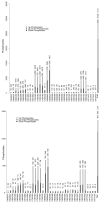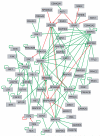Inferring the Sign of Kinase-Substrate Interactions by Combining Quantitative Phosphoproteomics with a Literature-Based Mammalian Kinome Network
- PMID: 21552464
- PMCID: PMC3087296
- DOI: 10.1109/BIBE.2010.75
Inferring the Sign of Kinase-Substrate Interactions by Combining Quantitative Phosphoproteomics with a Literature-Based Mammalian Kinome Network
Abstract
Protein phosphorylation is a reversible post-translational modification commonly used by cell signaling networks to transmit information about the extracellular environment into intracellular organelles for the regulation of the activity and sorting of proteins within the cell. For this study we reconstructed a literature-based mammalian kinase-substrate network from several online resources. The interactions within this directed graph network connect kinases to their substrates, through specific phosphosites including kinasekinase regulatory interactions. However, the "signs" of links, activation or inhibition of the substrate upon phosphorylation, within this network are mostly unknown. Here we show how we can infer the "signs" indirectly using data from quantitative phosphoproteomics experiments applied to mammalian cells combined with the literature-based kinase-substrate network. Our inference method was able to predict the sign for 321 links and 153 phosphosites on 120 kinases, resulting in signed and directed subnetwork of mammalian kinase-kinase interactions. Such an approach can rapidly advance the reconstruction of cell signaling pathways and networks regulating mammalian cells.
Figures



Similar articles
-
PhosNetVis: A web-based tool for fast kinase-substrate enrichment analysis and interactive 2D/3D network visualizations of phosphoproteomics data.Patterns (N Y). 2025 Jan 10;6(1):101148. doi: 10.1016/j.patter.2024.101148. eCollection 2025 Jan 10. Patterns (N Y). 2025. PMID: 39896259 Free PMC article.
-
PhosNetVis: A web-based tool for fast kinase-substrate enrichment analysis and interactive 2D/3D network visualizations of phosphoproteomics data.ArXiv [Preprint]. 2024 Dec 18:arXiv:2402.05016v4. ArXiv. 2024. Update in: Patterns (N Y). 2025 Jan 10;6(1):101148. doi: 10.1016/j.patter.2024.101148. PMID: 39010877 Free PMC article. Updated. Preprint.
-
Inference of kinase-signaling networks in human myeloid cell line models by Phosphoproteomics using kinase activity enrichment analysis (KAEA).BMC Cancer. 2021 Jul 8;21(1):789. doi: 10.1186/s12885-021-08479-z. BMC Cancer. 2021. PMID: 34238254 Free PMC article.
-
From Phosphosites to Kinases.Methods Mol Biol. 2016;1355:307-21. doi: 10.1007/978-1-4939-3049-4_21. Methods Mol Biol. 2016. PMID: 26584935 Review.
-
Inferring kinase activity from phosphoproteomic data: Tool comparison and recent applications.Mass Spectrom Rev. 2024 Jul-Aug;43(4):725-751. doi: 10.1002/mas.21808. Epub 2022 Sep 26. Mass Spectrom Rev. 2024. PMID: 36156810 Review.
Cited by
-
Global phosphorylation analysis of beta-arrestin-mediated signaling downstream of a seven transmembrane receptor (7TMR).Proc Natl Acad Sci U S A. 2010 Aug 24;107(34):15299-304. doi: 10.1073/pnas.1008461107. Epub 2010 Aug 4. Proc Natl Acad Sci U S A. 2010. PMID: 20686112 Free PMC article.
-
Identification of extracellular signal-regulated kinase 1 (ERK1) direct substrates using stable isotope labeled kinase assay-linked phosphoproteomics.Mol Cell Proteomics. 2014 Nov;13(11):3199-210. doi: 10.1074/mcp.O114.038588. Epub 2014 Jul 14. Mol Cell Proteomics. 2014. PMID: 25022875 Free PMC article.
References
-
- Manning G, Whyte DB, Martinez R, Hunter T, Sudarsanam S. The Protein Kinase Complement of the Human Genome. Science. 2002;298:1912–1934. - PubMed
-
- Alonso A, Sasin J, Bottini N, Friedberg I, Friedberg I, Osterman A, Godzik A, Hunter T, Dixon J, Mustelin T. Protein Tyrosine Phosphatases in the Human Genome. Cell. 2004;117:699–711. - PubMed
-
- de la Fuente van Bentem S, Mentzen WI, de la Fuente A, Hirt H. Towards functional phosphoproteomics by mapping differential phosphorylation events in signaling networks. Proteomics. 2008;8:4453–4465. - PubMed
Grants and funding
LinkOut - more resources
Full Text Sources
